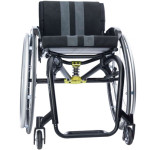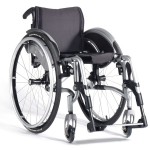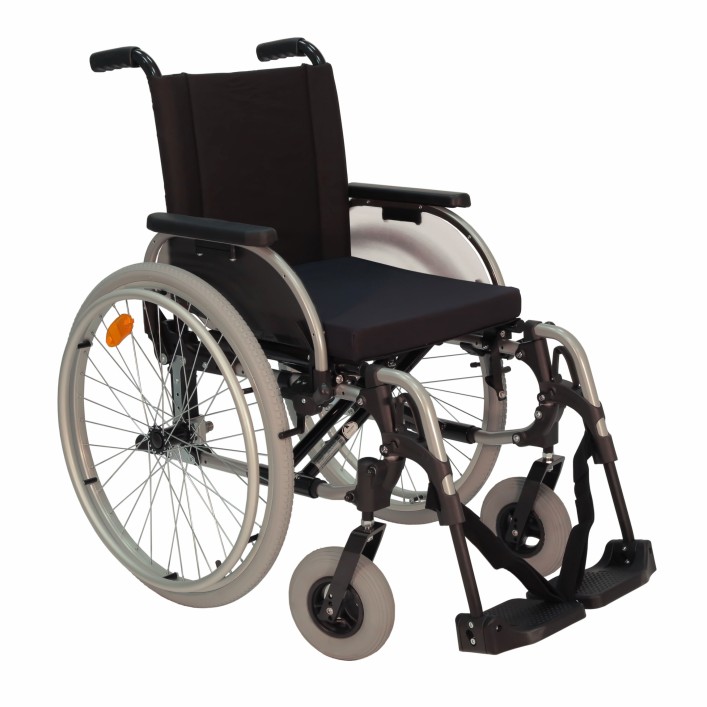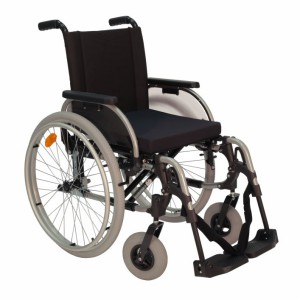Man choosing a wheelchair, lost the ability to move freely in space, currently, it is a difficult and responsible process. Ten years ago, this problem didn't exist at all., since there was no today's variety of disabled vehicles.
Strollers with fixed armrests are quite simple and reliable., their construction is strong and stable, they provide reliable placement of the patient in the wheelchair, safe movement. but, fixed armrests make it difficult for the patient to transplant.
Solid tires are reliable and durable, but are intended for the movement of the stroller exclusively on a flat, hard surface, since any unevenness will be given throughout the body of the rider of the stroller. Usually wheelchairs with such tires are used indoors.. Pneumatic tires are much more comfortable to travel on the street., as they absorb small irregularities, but require replacement and swapping over time.
Modern types of strollers include removable or reclining armrests, which creates the convenience of a quick transplant, height-adjustable and swivel footrests, which provide comfortable placement of sick limbs of a disabled person, seat height adjustable, armrests. Reclining back and headrest – create convenience and a certain comfort in everyday use, folding frame will free up space for storing the stroller and create convenience during transportation.
Models of wheelchairs of active type, allow patients and disabled people with partial loss of musculoskeletal function to lead an active lifestyle, move quickly and easily, maneuver in space, even play certain sports. These strollers are very light., maneuverable, quickly understood and popular with young people. Move in them, with a certain skill, creates a sense of fulfillment in the patient.
Electric wheelchairs are justified if funds are available and allow a disabled person to move comfortably in space. Foreign electric drive is reliable and easy to operate, easy to maintain, adapted to Russian conditions, safe for the disabled.
Now about the manufacturers ... Russian strollers of the Stavrovsky plant – centenarians. They've been out for a long time, easy to operate, although somewhat heavy and eventually require replacement of some parts. American technology is made exclusively on solid tires.
These strollers are modern, inexpensive, convenient and reliable. Stroller from Germany will last a long time, they are made with exceptional care and thoughtfulness. Strollers of a new generation of a Russian company “Inva Engineering” are assembled according to foreign technology in Moscow and have all the above advantages: they have a modern design, comfortable, reliable, light and inexpensive, promising for further exploitation.
Wheelchair selection – strollers
intended for patients, who cannot move independently. When choosing a wheelchair, it is necessary to take into account the anatomical features of the patient and environmental factors.. special requirements, required to take measurements from the patient, no, however desirable, for the patient to be in a wheelchair, best suited to its size..
For the correct selection of a wheelchair, it is necessary to measure the patient in 6 main positions:
• seat width;
• seat depth;
• leg length;
• seat height;
• forearm height;
• back height.
Choosing the right wheelchair will help:
• to ensure the distribution of the patient's weight on the widest possible surface;
• facilitate movement and prevent contact and friction of body parts against the side walls;
• by setting the maximum width of the wheelchair, minimize the problem of movement in the door, bathroom and other confined spaces.
Determining the Width of a Wheelchair Seat
Determining the seat width is the most important measurement. The task is, so that:
– to ensure the distribution of the patient's weight on the widest possible surface;
– facilitate movement and prevent contact and friction of body parts against the side walls;
– set the maximum width of the wheelchair with this calculation, to minimize the problem of movement in the door, bathroom and other confined spaces.
The measurement is taken across the widest areas of the thighs or ilium using a tape measure.. To the resulting value is added 5 cm. When measuring, one should also take into account the possibility of using thick clothing by the patient..
Example.
Dimensions, taken at the widest part of the patient's thighs or ilium, amounted to 40 cm, in this case, the normal width of the seat should be equal to 46 cm. This will provide additional clearance 2,5 cm on each side.
Seat is too narrow. The volume of movement and the degree of mobility will be sharply limited due to the fact, that it is difficult to rotate the body along the axis. Because the patient's weight is distributed over a smaller area, it increases the pressure on the ischial tuberosities. It can cause secondary complications, associated with the formation of bedsores.
Seat is too wide. A seat that is too wide gives rise to difficulties as a physical, and external order. Decreased stability while sitting, and this affects the correct position of the body. It may be difficult to move the chair forward. To facilitate the forward movement of the stroller, the patient will have to resort to the help of hands.
Increasing the width of the seat even by 1,25 cm can make it impossible to move through doorways, going to the toilet and using public transport.
Council. To check that the patient dimensions match the chair width, place both palms between the patient's thighs and the side walls. Hands should be free, no side pressure.
Determining the Depth of a Wheelchair Seat
Seat Depth Determination. The distribution of body weight on the buttocks and thighs should occur in this way, so as not to cause excessive pressure on the ischial tuberosities. At the same time, circulatory disorders and irritations of the skin and popliteal region are prevented..
The measurement is carried out with a measuring tape, marking the distance from the edge of the buttock along the thigh to the inner bend of the knee. To get the correct seat depth, subtract 5-7.5 cm from the obtained value.
Example. The total amount was 46 cm, subtract from it 5 cm. Seat depth, Thus, it turns out 41 cm.
Seat depth too low. If the seat depth is too small, then the extra body weight is distributed to the buttocks and thighs, as a result, pressure on the buttocks increases and the center of gravity shifts. Deviations of this kind increase the risk of the patient falling forward when the wheelchair is in motion..
Seat depth too deep. Excessive chair depth can interfere with blood circulation due to pressure and cause skin irritation in the upper calf and popliteal region.
To check chair depth for patient dimensions, measure the distance between the front edge of the seat upholstery or seat cushion and the heated area. It must be no more than wide. 3-4 fingers, etc. is. approximately 7,5 cm.
Determination of leg length. This dimension and the next, related to seat height, should be evaluated together
In this case, it is necessary to ensure the location of the platform of the feet at the level 5 cm from floor surface. This allows you to safely make turns with your torso and shoulders.. Setting the correct seat height, it is possible to exclude squeezing or circulatory disorders in this area.
Measurement is taken from the heel or edge of the heel, if the patient is wearing shoes, up to thigh level. When taking measurements, it is advisable to use a seat cushion. Usually, This device is used by all, who uses a wheelchair. The pillow provides the necessary degree of comfort and reduces pressure on the skin.
Footwell too low. External order and security issues arise. Torso and shoulder turns become difficult and unsafe. Rotating wheels can cause damage to the ankles, if the feet hang down due to the too low position of the platform. The patient may fall out of the chair, if the site touches some kind of elevation.
Council. Dimensional checks should ensure that the minimum distance between the floor surface and the base of the foot platform is not less than 5 cm.
Determining the seat height
The purpose of the measurement is, so that:
1) prevent the formation of pressure zones on skin areas in the buttocks and popliteal region;
2) provide the patient with the correct height, allowing to achieve optimal conditions of movement, and also protect his knees from possible collision with various objects.
The seat height is measured by adding 5 cm to bent leg length. This will ensure that the foot pad is properly connected with a safe clearance from the floor of at least 5 cm. Seat height increase per 2,5 cm should be accompanied by an increase in the gap between the floor and the footwell.
If a polyurethane cushion is used for the seat, then under the pressure of normal body weight, its volume will decrease by half. Hence, if cushion height 10 cm, then under the pressure of the weight, its height will decrease to 5 cm.
Measurement is taken from the floor to the level of the seat. Consideration, whether the patient will use the seat cushion.
Stroller seat and footrest too low. Too low position of the footrest is unsafe for the patient. The patient should be seated higher, using a pillow, and reinstall the footrest.
Seat set too low. The buttocks will experience excess pressure. This is a suitable option for pillow use, if the patient has not yet used it.
Seat set too high. The high position of the knees makes it inconvenient to perform actions at the table.
Council. Compliance check: enter without effort, at least, two fingers under the surface of the thigh to the depth of the second joint, sliding under upholstery or cushion surfaces. This will fit 3.75-5cm.
Determining the height of the armrests
To help the patient maintain proper seating position and balance, it is necessary to measure from the surface of the seat to the base of the elbow. Add to the resulting value 2,5 cm. Armrests are installed at this height. Armrests set too high.
If the armrests are too high, shoulders will be raised, which leads to muscle fatigue. On the other hand, the patient will not be able to use the armrest as intended, and this will lead to instability in the sitting position.
Armrests too low. Low-lying armrests make it difficult for the patient to take a comfortable position. The patient will have to slouch, to rest your forearms on the armrests. This crouching position can cause fatigue., disturb balance and even affect breathing. Aperture movements will be limited, leading to decreased respiratory function.
 Determination of the height of the back of the chair
Determination of the height of the back of the chair
Recently, when designing a chair, a low back is provided.. The backrest height should be adjusted according to the patient's disability and activity level.. Properly set height and shape of the back will provide a comfortable posture for the patient in the chair and a stable position of his torso.
When measuring, the height from the surface of the seat to the armpit is determined, while the patient's arms should be extended forward and parallel to the floor surface. To accurately set the height of the back of the chair, taking into account the thickness of the upholstery, subtract from the resulting height 10 cm. This height provides minimal torso support..
If full torso support is required, measure the height from the seat surface to the desired level of support. (usually at shoulder height, neck, middle part of the head). If you need full support of the body, you can choose a chair with a back, allowing you to lean back, and in some cases recommend using a chair back with sectional height adjustment. It allows you to change the level of support as you, how the function of individual segments of the body is restored in the patient.
Council. When checking the correct selection of the height of the chair back for patients with minimal trunk dysfunction, four fingers of the left hand should fit freely in the gap between the upper edge of the upholstery of the chair and the level of the armpit. This distance is 10 cm.





